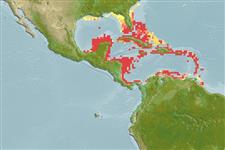Environment: milieu / climate zone / depth range / distribution range
Écologie
marin récifal; profondeur 0 - 40 m (Ref. 9710). Tropical; 33°N - 7°N, 96°W - 58°W
Western Atlantic: Bermuda and southern Florida, USA to northern South America; throughout the Caribbean (Ref. 13442). Including Antilles (Ref. 26938).
Taille / Poids / Âge
Maturity: Lm ? range ? - ? cm
Max length : 29.0 cm FL mâle / non sexé; (Ref. 6937)
Épines dorsales (Total) : 10; Rayons mous dorsaux (Total) : 12. Snout long and pointed. Black stripes and bars forming irregular rectangles on body. Has unique pointed snout and distinct color pattern make it easy to identify (Ref. 26938).
Most common in areas with rock or scattered coral. Solitary or in pairs. Feeds mainly upon crustaceans (Ref. 5521). Synchronously hermaphroditic. The most common member of the genus (Ref. 9710).
Life cycle and mating behavior
Maturities | Reproduction | Spawnings | Egg(s) | Fecundities | Larves
Displays facultative monogamy where males are constrained to mate with a single female due to resource limitation (Ref. 52884). Pelagic spawner (Ref. 32216).
Robins, C.R. and G.C. Ray, 1986. A field guide to Atlantic coast fishes of North America. Houghton Mifflin Company, Boston, U.S.A. 354 p. (Ref. 7251)
Statut dans la liste rouge de l'IUCN (Ref. 130435)
Menace pour l'homme
Harmless
Utilisations par l'homme
Pêcheries: commercial; Aquarium: Commercial
Outils
Articles particuliers
Télécharger en XML
Sources Internet
Estimates based on models
Preferred temperature (Ref.
123201): 25.3 - 28.1, mean 27.1 °C (based on 138 cells).
Phylogenetic diversity index (Ref.
82804): PD
50 = 0.5000 [Uniqueness, from 0.5 = low to 2.0 = high].
Bayesian length-weight: a=0.01023 (0.00614 - 0.01704), b=3.04 (2.90 - 3.18), in cm total length, based on LWR estimates for this species & Genus-body shape (Ref.
93245).
Niveau trophique (Ref.
69278): 3.5 ±0.37 se; based on food items.
Résilience (Ref.
120179): Milieu, temps minimum de doublement de population : 1,4 à 4,4 années (Preliminary K or Fecundity.).
Fishing Vulnerability (Ref.
59153): Low vulnerability (22 of 100).
Nutrients (Ref.
124155): Calcium = 50.5 [31.2, 89.5] mg/100g; Iron = 0.572 [0.316, 0.948] mg/100g; Protein = 18.4 [16.6, 20.0] %; Omega3 = 0.148 [0.100, 0.221] g/100g; Selenium = 28.3 [18.0, 49.0] μg/100g; VitaminA = 112 [41, 346] μg/100g; Zinc = 1.29 [0.90, 1.80] mg/100g (wet weight);
